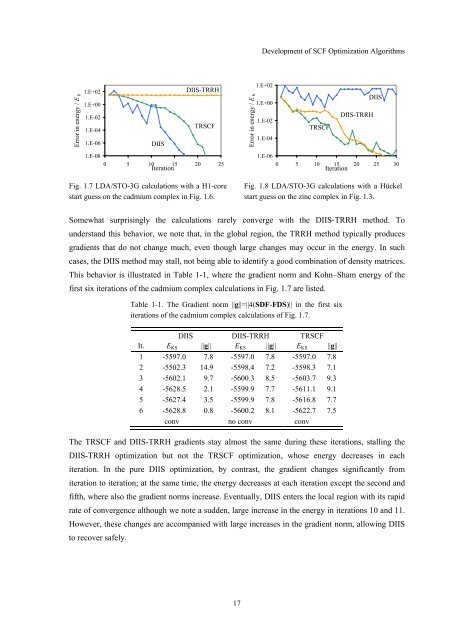Get my PhD Thesis
Get my PhD Thesis
Get my PhD Thesis
Create successful ePaper yourself
Turn your PDF publications into a flip-book with our unique Google optimized e-Paper software.
Development of SCF Optimization Algorithms<br />
Error in energy / E h<br />
1.E+02<br />
1.E+00<br />
1.E-02<br />
1.E-04<br />
1.E-06<br />
1.E-08<br />
DIIS<br />
DIIS-TRRH<br />
TRSCF<br />
0 5 10 15 20 25<br />
Iteration<br />
Fig. 1.7 LDA/STO-3G calculations with a H1-core<br />
start guess on the cadmium complex in Fig. 1.6.<br />
Error in energy / E h<br />
1.E+02<br />
1.E+00<br />
1.E-02<br />
1.E-04<br />
1.E-06<br />
TRSCF<br />
DIIS-TRRH<br />
DIIS<br />
0 5 10 15 20 25 30<br />
Iteration<br />
Fig. 1.8 LDA/STO-3G calculations with a Hückel<br />
start guess on the zinc complex in Fig. 1.3.<br />
Somewhat surprisingly the calculations rarely converge with the DIIS-TRRH method. To<br />
understand this behavior, we note that, in the global region, the TRRH method typically produces<br />
gradients that do not change much, even though large changes may occur in the energy. In such<br />
cases, the DIIS method may stall, not being able to identify a good combination of density matrices.<br />
This behavior is illustrated in Table 1-1, where the gradient norm and Kohn–Sham energy of the<br />
first six iterations of the cadmium complex calculations in Fig. 1.7 are listed.<br />
Table 1-1. The Gradient norm ||g||=||4(SDF-FDS)|| in the first six<br />
iterations of the cadmium complex calculations of Fig. 1.7.<br />
DIIS DIIS-TRRH TRSCF<br />
It. E KS ||g|| E KS ||g|| E KS ||g||<br />
1 -5597.0 7.8 -5597.0 7.8 -5597.0 7.8<br />
2 -5502.3 14.9 -5598.4 7.2 -5598.3 7.1<br />
3 -5602.1 9.7 -5600.3 8.5 -5603.7 9.3<br />
4 -5628.5 2.1 -5599.9 7.7 -5611.1 9.1<br />
5 -5627.4 3.5 -5599.9 7.8 -5616.8 7.7<br />
6 -5628.8 0.8 -5600.2 8.1 -5622.7 7.5<br />
conv no conv conv<br />
The TRSCF and DIIS-TRRH gradients stay almost the same during these iterations, stalling the<br />
DIIS-TRRH optimization but not the TRSCF optimization, whose energy decreases in each<br />
iteration. In the pure DIIS optimization, by contrast, the gradient changes significantly from<br />
iteration to iteration; at the same time, the energy decreases at each iteration except the second and<br />
fifth, where also the gradient norms increase. Eventually, DIIS enters the local region with its rapid<br />
rate of convergence although we note a sudden, large increase in the energy in iterations 10 and 11.<br />
However, these changes are accompanied with large increases in the gradient norm, allowing DIIS<br />
to recover safely.<br />
17

















